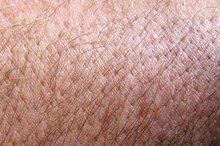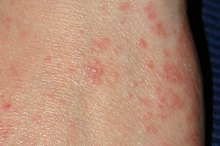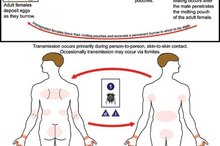What does fact checked mean?
At Healthfully, we strive to deliver objective content that is accurate and up-to-date. Our team periodically reviews articles in order to ensure content quality. The sources cited below consist of evidence from peer-reviewed journals, prominent medical organizations, academic associations, and government data.
The information contained on this site is for informational purposes only, and should not be used as a substitute for the advice of a professional health care provider. Please check with the appropriate physician regarding health questions and concerns. Although we strive to deliver accurate and up-to-date information, no guarantee to that effect is made.
Causes of Itchy Skin Rash
An itchy skin rash can indicate an underlying health condition or disease, or can simply be a response to contact with an irritating substance 1. Determining the cause is important, because treatments differ for the various types of itchy rash. Further, certain illnesses and conditions that cause rash are contagious.
Eczema
Eczema is a skin condition that causes patches of skin to become dry, red, inflamed and itchy 14. Small, fluid-filled blisters or weeping sores may develop in the rash and, over the long term, skin can begin to feel leathery as a result of excessive scratching.
Atopic dermatitis, commonly known as “atopic eczema,” is the most common form of eczema. The American Academy of Dermatology estimates that between 10 percent and 20 percent of children develop atopic dermatitis, most often before age 5, and that between 1 percent and 3 percent of adults develop the condition.
Eczema tends to run in families, indicating a genetic basis for the condition. Although the condition varies from person to person, sufferers tend to notice certain irritants that set off an outbreak. Milk and wheat products, eggs and nuts seem to initiate an outbreak in some people. Pollen and pet dander have been noted as triggers for others.
- Eczema is a skin condition that causes patches of skin to become dry, red, inflamed and itchy 1.
- Small, fluid-filled blisters or weeping sores may develop in the rash and, over the long term, skin can begin to feel leathery as a result of excessive scratching.
Infestation
Side Effects of a Bedbug Bite
Learn More
Certain parasites can trigger itchy skin rashes in humans 1. Mites, which are tiny, wingless bugs, burrow under the upper layer of skin to feed and lay their eggs. Because mites don't fly, they are generally passed through direct skin-to-skin contact. A female mite lays about three eggs per day over a lifetime of one to two months. The rash caused by a mite infestation is called “scabies” in general cases and “crusted scabies” or “Norwegian scabies” in intense forms. The rash appears as small red bumps and is accompanied by intense itching. It's caused by an allergic reaction to the mites’ waste products. The mite’s burrow can appear as a slightly raised trail underneath the skin.
When the itchy rash appears on the scalp, a lice infestation may be to blame. Lice do not fly, but they move quickly and are passed from person to person when close contact occurs. On the new host, lice anchor themselves onto hair shafts and bite the scalp, which they inject with saliva. This allows them to feed on blood and causes the host to break out in an itchy rash. They lay their eggs on the scalp next to a hair shaft, where body heat helps the eggs to incubate. Lice can also infect the pubic area (pubic lice) and the body (body lice), causing an itchy rash in those areas.
- Certain parasites can trigger itchy skin rashes in humans 1.
- Lice can also infect the pubic area (pubic lice) and the body (body lice), causing an itchy rash in those areas.
Chickenpox
Chickenpox is an itchy rash that often begins on the stomach before spreading to the rest of the body. As it takes its course, small, red, fluid-filled blisters form on the body that, if scratched, can result in permanent scarring. Left alone, the blisters eventually dry out, usually within five to 10 days, and form scabs. Until all blisters have scabbed, a person remains contagious. Caused by the herpes zoster virus, chickenpox spreads easily and rapidly and usually affects children younger than 10. When it affects adults, serious complications can occur, including Reye’s syndrome and Guillain-Barr syndrome.
- Chickenpox is an itchy rash that often begins on the stomach before spreading to the rest of the body.
- Left alone, the blisters eventually dry out, usually within five to 10 days, and form scabs.
Related Articles
References
- Mayo Clinic: Itchy Skin
- Medline Plus: Rashes
- DermaNet NZ: Scabies
- Cleveland Clinic: Dry skin/Itchy Skin
- Maliyar K, Sibbald C, Pope E, Gary sibbald R. Diagnosis and Management of Atopic Dermatitis: A Review. Adv Skin Wound Care. 2018;31(12):538-550. doi: 10.1097/01.ASW.0000547414.38888.8d
- Kanani, A., Betschel, S.D. & Warrington, R. Urticaria and angioedema. Allergy Asthma Clin Immunol 14, 59 (2018) doi:10.1186/s13223-018-0288-z
- Martin SF, Rustemeyer T, Thyssen JP. Recent advances in understanding and managing contact dermatitis. F1000Res. 2018;7:F1000 Faculty Rev-810. Published 2018 Jun 20. doi:10.12688/f1000research.13499.1
- Atopic Dermatitis Practice Parameters. Ann Allergy Asthma Immunol. 2004;93:S1-21.
- Beltrani VS, Bernstein IL, Cohen DE, Fonacier L. Contact Dermatitis: A Practice Parameter. Ann Allergy Asthma Immunol. 2006;97:S1-38.
- Practice Parameters for Disease Management: Acute and Chronic Urticaria and Angioedema. Ann Allergy. 2000; 85: S525-44.
Writer Bio
Katherine Mariaca is a professional freelance journalist who specializes in alternative and complementary medicine, and skin and body care treatments. A longtime spa director and VP of skin care companies, Mariaca developed products and services for the spa industry. She earned a B.S. from Tufts and an M.F.A. from Lesley.








